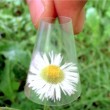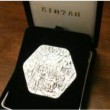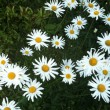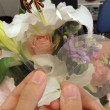「透明な紙」と「セルロースナノファイバー」、これだけ知れば世界最先端!!!
ver 1.0 (2019年10月20日, 日本語版)
内容
セクション1 透明、半透明、不透明
セクション2 透明性について(問1~4)
セクション3 透明+透明=透明?(問5)
セクション4 セルロースナノファイバーを使った2種類の透明材料(問6)
セクション5 透明複合材料(問7~8)
セクション6 透明な紙(問9)
セクション7 透明な紙、透明性を操る(問10~15)
セクション8 透明な紙、耐熱性を操る(問16~20)
セクション1 透明、半透明、不透明
これらYoutubeを見て、理解してね。
https://www.youtube.com/watch?v=p2DS_wgrEBc
https://www.youtube.com/watch?v=P6Uihn8V3h4
セクション2 透明性について
問1 下記論文から、質問の答えを探してください。
http://dx.doi.org/10.1063/1.4804361
問1-1 フレネル反射とは?(文章を抜き出してください)
問1-2 空気(屈折率1.0)中に屈折率1.5の透明な材料がある場合、透明な材料の反射率(surface reflection)(%)と全光線透過率(total transmittance)を求めてください。
問1-3 屈折率1.5の気体中に、屈折率1.5の透明な材料がある場合、透明な材料の反射率(surface reflection)(%)と全光線透過率(total transmittance)を求めてください。
問2 下記URLを読んで、質問の答えとなる式・文章を抜き出してください。
http://file.yizimg.com/175706/2011120519401287.pdf
問2-1 全光線透過率(total luminous transmittance “Tt”)を示す式を抜き出してください。
問2-2 拡散光線透過率(diffuse luminous transmittance “Td”)を示す式を抜き出してください。
問2-3 ヘイズ(haze)を定義している文章と式を抜き出してください。。
(ヒント)学術的な英文では、定義式は”where”という術語をセットになって書いてあります。もし式の周りに、”where”という術語が見当たらない場合、その式は既に定義済み、または単なる式の導出過程です。
これを見てください
https://en.wikipedia.org/wiki/Ideal_gas_law#Combined_gas_law
“PV/T=k, where P is the pressure…., V is the volume…”
https://en.wikipedia.org/wiki/Newton%27s_laws_of_motion
“F=ma, where F is …., m is ….”
問3 光吸収しない透明材料に光が入射すると、光の一部は表面で反射し、残りの光が材料の中へと透過します。反射する光の割合は、フレネル反射の式で概算できます。透過する光は、材料をまっすぐ進む直線透過光(regular lights)と拡散しながら進む拡散透過光(diffused lights)の2種類に分類できます。直線透過光はまっすぐ進むので、直線透過光率(regular transmittance)を測定すると、サンプルと検出器の距離に関係なく一定の値を示します。一方、拡散透過光は広がりながら進むので、拡散透過光率(diffuse transmittance)の測定値は、サンプルと検出器の距離によって変化します。
下記の問いでは、入射光(incident light)をIL、反射光(reflection light)をRL、直進光(regular light)をTr、拡散光(diffused light)をTd、透過光(transmitted light)をTtと表記し、式を答えてください。
問3-1 TtとTd、Trの関係を式で表してください。
問3-2 ILとRL、Td、Trの関係を式で表してください。
問3-3 TtとTrを使って、ヘイズ(H)を式で表してください。
問4 ガラスと摺りガラスは外観が大きく異なりますが、全光線透過率(total transmittance)は同じです。また、両方とも屈折率が同じなので、表面反射率(surface reflection)も同じです。したがって、その大きく異なる外観は、直線透過光率(regular transmittance)や拡散透過光率(diffuse transmittance)に依存しています。
問4-1 どちらの拡散透過光率(diffuse transmittance)が大きいですか?また、どちらの直線透過光率(regular transmittance)が大きいですか?
問4-2 ある物体をガラス越しに見たとき、物体とガラスの距離に関わらず、物体の外観は同じです。「直線透過光率」と「距離」という言葉を使って、その理由を記述してください。
問4-3 ある物体を、摺りガラス越しにくっきりと見るためにはどのようにしたらよいでしょう(テープなどを使って、摺りガラスの表面を平らにする方法は除く)?「拡散透過光率」と「距離」という言葉を使って、その方法を記述してください。
セクション3 透明+透明=透明?
「透明」と「目に見えない」は、同じでしょうか?違うでしょうか?
空気は透明で、普通は目に見えませんね。では、空気は「目に見えない」ものでしょうか?
あなたの周りにある空気は見えませんが、水中にある空気は見えますね。
これはありふれた現象ですが、上手に説明することは難しいですね。
下記URLの写真を見てください。
http://www.nogimasaya.com/research/detail/what-is-transparent/
左のガラス棒は見えますがが、右のガラス棒は見えません。これを説明するキーワードは「屈折率」です。空気の屈折率は1.0で、ガラスの屈折率は1.5です。左の液体は水で、水の屈折率は1.3です。右の液体は砂糖水で、その屈折率は1.5で問5-1 砂糖水に入ったガラス棒の反射率(surface reflection %)はいくつですか?(ヒント:問1-3)
問5-2 砂糖水に入ったガラス棒が目に見えない理由を説明してください。
問5-3 水に入ったガラス棒の反射率(surface reflection %)はいくつですか?
問5-4 水に入ったガラス棒が目に見える理由を説明してください。
問5-5 炭酸水を振ると、水中の泡は白く見えます。泡が白く見える理由を、以下3つのキーワードを使って説明してください。(キーワード:屈折率・反射・拡散光または直進光説明)
セクション4 セルロースナノファイバーを使った2種類の透明材料
問6 セルロースナノファイバーを使った透明材料は、2種類あります。下記論文から、2種類の透明材料とそれらが透明である理由を記述している文章を抜き出てください。
http://dx.doi.org/10.1063/1.4804361
セクション5 透明複合材料
このセクションでは、屈折率マッチングに注目して透明複合材料(セルロースナノファイバーに関係なく)の作り方について理解しましょう。
複合材料とは、2種類またはそれ以上の材料を混ぜた材料です。そして、主要成分をマトリクス、サブ成分 をフィラー(補強材)と呼びます。
プラスチックを繊維で補強した繊維強化プラスチック(FRP)は、複合材料として有名です。繊維としてはガラス繊維や炭素繊維、プラスチックとしてはエポキシ樹脂やビニル樹脂ポリエステル系の熱硬化樹脂を使用することが多く、これらの繊維複合材料は飛行機、自動車、船舶や建設材料として使用されます。
問
Q7. Theoretically, the refractive index matching is simple/ easy concept. In the practical, however, it is very hard to realize.
After reading this article, please pick up the answer sentences.
https://doi.org/10.1063/1.2146056
Q7-1. How much the accurate matching of refractive indexes do we need, when we used micro-sized fillers?
Q7-2. The nanosized fibers are free from light scattering, because its diameters are enough smaller than the visible light wavelength. How much the range of refractive index can be acceptable for cellulose nanofiber to make the transparent composites ?
Q7-3. Using the micro-sized fillers, the accurate matching is a disadvantage against the atmosphere temperature change. Please explain the detail in the epoxy-resin and glass composite. (temperature range, refractive index and transparency change)
Q7-4. In the above question, you explained the epoxy/glass composites changed their transparency against the temperature change.
To compared with it, in this article, BC (bacterial cellulose) is used as the cellulose nanofibers (filler), and acrylic resin was used as the matrix.
How about the transparency of cellulose nanofiber composite against the temperature change. Please pick-up the answer sentences, which include the temperature and refractive index change.
Q8. To review your understanding, let’s have a “thought experiment”, how to make the transparent composites. Here, we set the refractive index glass to 1.5, epoxy resin to 1.3, cellulose to 1.5, and air to 1.0.
Q8-1. Fibre-reinforced plastic consist of glass fiber (their width is micro-size) and epoxy resin. The glass fiber itself is transparent and the epoxy resin itself is also transparent. But, there is no transparent FRP using glass fiber and epoxy resin in our daily life. Please explain the reason, except for the fiber width.
Q8-2. What kind of matrix plastics should you prepare to make the transparent composite using the micro-sized GLASS fibers as the filler?
Q8-3. Please write two answers. What kind of glass fiber should you prepare to make the transparent composite using the matrix plastics with the refractive index of 1.3
Q8-4. What kind of matrix plastics should you prepare to make the transparent composite using the micro-sized PULP fibers as the filler?
Q8-5. Paper made from cellulose fibers (pulp fibers) is one kind of the composites, since they consist of two constituent materials of “cellulose” and “air”. Air itself is transparent and cellulose itself is also transparent, paper is not transparent. Please explain the reason.
Q8-6 There are three ways to make paper transparent. Please explain three methods, considering that the cellulose fibers are matrix (major components) and the air is the filler (minor components) in the paper. . It is a complete “thought experiment” !! So you can obtain any property or size in cellulose and air in this question. Let’s try to get the answers.
セクション6 透明な紙
Making nanopaper is 3 steps.
see Fig 1 in this URL
http://www.nogimasaya.com/research/detail/onenanofiber/
First one is purification of wood chips to make cellulose pulps.
Second one is the mechanical nanofibrillation of cellulose pulps.
Third one is the drying of cellulose nanofiber dispersion.
After drying, we got cellulose nanopaper.
Q9. Why the nanopaper is transparent?
After reading the original these articles,
https://doi.org/doi:10.1002/adma.200803174
http://dx.doi.org/10.1063/1.4804361
please pick up the answer sentence from these, which referred Adv Mater 2009.
https://doi.org/doi:10.1039/c7ra12672g
https://doi.org/doi:10.1038/srep17254
セクション7 透明な紙、透明性を操る
The transparency of nanopaper is controlled by some ways. First one is controlled by the starting pulp and/or pre-treatments, second one is by density, the third one is by concentration of nanofiber dispersion, and the fourth one is drying humidity. However, third one and fourth one are only for some particular conditions. In this section, you will understand the detail.
Q10. [starting pulp and/or pre-treatments] The below article mainly reported 3 nanopapers (Fig. 1a, 1b, and 1c). Fig. 1a and 1c are transparent nanopaper, and Fig. 1b is hazy nanopaper.
https://pubs.acs.org/doi/abs/10.1021/acsami.5b06915
Q10-1. In Fig 1a of transparent nanoaper, please answer what kind of pulp are used & how many times nanofibrillation?
Q10-2.In Fig 1b of translucent nanoaper, please answer what kind of pulp are used & how many times nanofibrillation?
Q10-3. In Fig 1c of transparent nanoaper, please answer what kind of pulp are used, how many times nanofibrillation, and the additional treatment name (2word)?
Q10-4. The additional treatment has 2 advantades. What are they? Let’s consider by yourself, not picking up the sentence.
Q10-5. There are 2 ways to obtain the transparent nanopaper. Please tell the the starting pulp and/or pre-treatments.
Q11. [starting pulp and/or pre-treatments] Fig 4 shows three nanopaper with various haze of 86.6%, 38.3% and 5.5%.
Why is nanopaper (a, c) so high hazy? Please pickup the answer sentences, which discussed about the fiber width and their shape.
http://dx.doi.org/10.1038/srep41590
Q12. [starting pulp and/or pre-treatments] Table 1 shows the nanopaper haze in various TEMPO nanopaper. These TEMPO nanopaper were made from the different TEMPO pulp, the same nanofibrillation condition, and the same drying procedures.
https://pubs.acs.org/doi/abs/10.1021/acsami.5b06915
Q12-1. What control the TEMPO nanopaper haze?
Q12-2. Two (or three) parameters in TEMPO nanopaper was changed by its increasing. Please explain what they are & how they parameter changed.
Q13. [Density] In Fig.1, all the nanopaper are made from the holocellulose pulps (the same nanofiber dispersion). Although using the same nanofiber, their appearance are quite different, but their total transmittance are roughly the same.
What is the reason? Please pick up the answer sentnces (2-3 lines), considering below the points.
How much are their total transmitance values?
In these nanopaper, something is the same in their procedures, but something is different (changed) at their properties.
http://dx.doi.org/10.1038/srep41590
Q14. [concentration of nanofiber dispersion] Kasuga et al. reported that “Cellulose nanofibers were homogeneously distributed in the low-concentration dispersion but tended to aggregate inhomogeneously in the high-concentration dispersion. The inhomogeneous aggregations cannot produce clearly transparent nanopaper with haze values of less than 10%.” So, using the particular cellulose pulps/nanofibers, the haze of nanopaper sometimes are changed by the concentration of nanofiber dispersion. Howverer, its mechanism or reason are still unknown..
https://doi.org/10.3390/nano8020104
Q14-1. Fig. 1 shows that the nanopaper haze keep the constant against the dispersion concentration. What kind of pulps were used for the nanopaper? How to make the pulps (pick up sentences, please) ?
Q14-2. Fig. 2 shows that the nanopaper haze increased with the dispersion concentration. What kind of pulps were used for the nanopaper? How to make the pulps (pick up sentences, please) ?
Q15. [drying humidity] Isobe et al. reported that “high-humidity drying decreased the nanopaper haze when they were produced from a concentrated dispersion.”
https://doi.org/10.1039/C7RA12672G
Q15-1.What kind of pulps were used for the nanopaper?
Q15-2 In Fig.2a & 2d, they compared two results under the different drying condition. Please explain the conditions of the concentration of dispersion, drying temperature, drying humidity, and the nanopaper appearance.
This article explained the reason/mechanism as below, “When the high-concentration nanofiber dispersion was subjected to high-humidity drying, the water proportion at the surface of the dispersion increased, and consequently the nanofiber aggregations were partly disintegrated.” The authors, however, are not satisfied with this explanations, because it is just a surface or shallow descriptions.
セクション8 透明な紙、耐熱性を操る
## Acetylation-1 (Okahisa 2014) ##
In cellulose, the acetylation is famous for the reduction of the hygroscopicity, since the hydroxyl groups of cellulose are replaced by less hydrophilic acetyl groups. This article firstly reported that the slight (surface) acetylation of cellulose nanofibers significantly reduces the hygroscopicity and improve the thermal resistance, while maintaining the high optical transparency.
If you are interested, please read it.
https://doi.org/10.1063/1.2403901
Q16. This article reported the acetylation of cellulose nanofiber materials. Please answer following three questions.
https://doi.org/10.1016/j.compscitech.2009.04.017
Q16-1. What kind of cellulose nanofibers were used? (pick up)
Q16-2. What kind of transparent materials were produced?
Q16-3. The fabrication of CNF composites was 4 steps, as follows. (1) Wood chips were purified to wood pulps. (2) Wood pulps turned to CNF dispersion. (3) CNF dispersion was dried to dried sheets. (4) The dried sheets were were impregnated in the matrix polymer.
In the acetylated CNF composites, the procedures become 5 steps since the acetylation step is needed. When is the acetylation is applied ? Please answer, for example “after (4) & before (5)”.
## Acetylation-2 (Yagyu 2017) ##
Q17. This article also reported the acetylation of cellulose nanofiber materials. Please answer following three questions.
https://doi.org/10.1088/2058-8585/aa60f4
Q17-1. What kind of cellulose nanofibers were used? (your word)
Q17-2. What kind of transparent materials were produced?
Q17-3. In Fig. 2a, cellulose nanopaper was fabricated by drying of the native cellulose nanofiber dispersion. The haze of the original nanopaperis around 10%. In contrast, the cellulose nanopaper is Fig. 2b is much higher haze over 80%. In Fig. 2b, please explain how to prepare the film, and why it is high haze. (pick up)
Q17-4. In Fig. 2c of the acetylated nanopaper, its haze is around 20%. Please explain how to prepare it, and when its appearance become translucent. (pick up)
Q17-5. In Fig. 2d-g of the acetylated nanopaper, their haze keep around 10%. Please explain how to prepare it (pick up).
Q17-6. In the Introduction, the author categorized into the two types of acetylated CNF film. Please pick up the sentences.
Q17-7. Is this article categorized into the first, the second, or new one? If it is the new one, please explain it. (pick up from abstract)
## NaBH4-reduction ( 2014) ##
Takaichi et al. (Saito’s group in Tokyo univ.) reported NaBH4-reduction improve the heat resistance of TEMPO pulp.
https://doi.org/10.1007/s10570-014-0444-7
As shown in Fig. 4, after heating (unknown temperature & time), TEMPO pulp (oven-dried TOC) became yellow, but NaBH4 treated TEMPO pulp (oven-dried NaBH4-TOC) keep white.
Q18-1. Please pick up a sentence how to do it, from the below article.
(TIP reffference number is 26)
https://pubs.acs.org/doi/full/10.1021/acsami.5b06915
Q18-2. In the process, what kind of cellulose was used, “pulp dispersion” or “nanofiber dispersion”? In the process, was the reduction “before nanofibrillation” or “after nanofibrillation” ?
## Carboxylate content in TEMPO nanopaper (Yagyu 2015) ##
This article reported the decreasing of carboxylate content improve the heat resistance of TEMPO pulp.
http://pubs.acs.org/doi/abs/10.1021/acsami.5b06915
Q19-1. From the abstract, when the parameter decreased, one property becomes better and two properties keep constant. Please answer better 1 and constant 2 parameter.
## Summary in this section ##
Q20-1. [Treatment types & its pulp] In this section, three methods are presented to improve the thermal resistance. Please answer them & their pulp.
Q20-2. [Category] Considering their processes, these 4 articles (Okahisa 2014, Takaichi 2014, Yagyu 2015 & 2017) can be separated in two group. Please categorize and its type (reason).
***** under construction… ****
© Department of Functionalized Natural Materials ISIR, Osaka University







